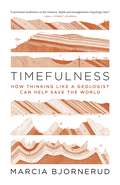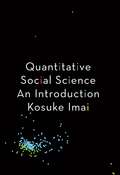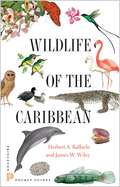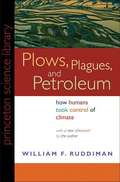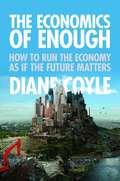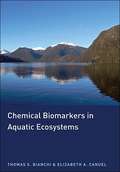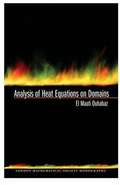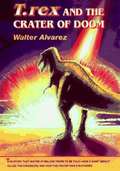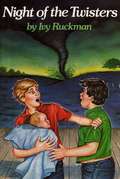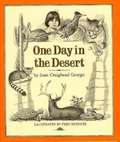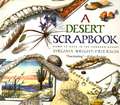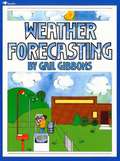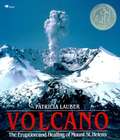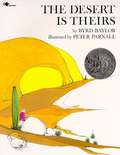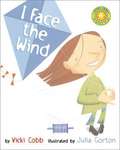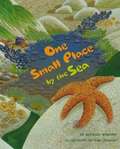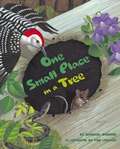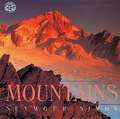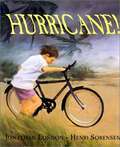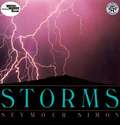- Table View
- List View
Timefulness: How Thinking Like a Geologist Can Help Save the World
by Marcia BjornerudWhy an awareness of Earth’s temporal rhythms is critical to our planetary survivalFew of us have any conception of the enormous timescales in our planet’s long history, and this narrow perspective underlies many of the environmental problems we are creating for ourselves. The passage of nine days, which is how long a drop of water typically stays in Earth’s atmosphere, is something we can easily grasp. But spans of hundreds of years—the time a molecule of carbon dioxide resides in the atmosphere—approach the limits of our comprehension. Our everyday lives are shaped by processes that vastly predate us, and our habits will in turn have consequences that will outlast us by generations. Timefulness reveals how knowing the rhythms of Earth’s deep past and conceiving of time as a geologist does can give us the perspective we need for a more sustainable future.Marcia Bjornerud shows how geologists chart the planet’s past, explaining how we can determine the pace of solid Earth processes such as mountain building and erosion and comparing them with the more unstable rhythms of the oceans and atmosphere. These overlapping rates of change in the Earth system—some fast, some slow—demand a poly-temporal worldview, one that Bjornerud calls “timefulness.” She explains why timefulness is vital in the Anthropocene, this human epoch of accelerating planetary change, and proposes sensible solutions for building a more time-literate society.This compelling book presents a new way of thinking about our place in time, enabling us to make decisions on multigenerational timescales. The lifespan of Earth may seem unfathomable compared to the brevity of human existence, but this view of time denies our deep roots in Earth’s history—and the magnitude of our effects on the planet.
Quantitative Social Science: An Introduction
by Kosuke ImaiAn introductory textbook on data analysis and statistics written especially for students in the social sciences and allied fields Quantitative analysis is an increasingly essential skill for social science research, yet students in the social sciences and related areas typically receive little training in it--or if they do, they usually end up in statistics classes that offer few insights into their field. This textbook is a practical introduction to data analysis and statistics written especially for undergraduates and beginning graduate students in the social sciences and allied fields, such as economics, sociology, public policy, and data science. Quantitative Social Science engages directly with empirical analysis, showing students how to analyze data using the R programming language and to interpret the results--it encourages hands-on learning, not paper-and-pencil statistics. More than forty data sets taken directly from leading quantitative social science research illustrate how data analysis can be used to answer important questions about society and human behavior. Proven in the classroom, this one-of-a-kind textbook features numerous additional data analysis exercises and interactive R programming exercises, and also comes with supplementary teaching materials for instructors. Written especially for students in the social sciences and allied fields, including economics, sociology, public policy, and data science Provides hands-on instruction using R programming, not paper-and-pencil statistics Includes more than forty data sets from actual research for students to test their skills on Covers data analysis concepts such as causality, measurement, and prediction, as well as probability and statistical tools Features a wealth of supplementary exercises, including additional data analysis exercises and interactive programming exercises Offers a solid foundation for further study Comes with additional course materials online, including notes, sample code, exercises and problem sets with solutions, and lecture slides
Wildlife of the Caribbean (Princeton Pocket Guides)
by James Wiley Herbert RaffaeleThis is the first comprehensive illustrated guide to the natural world of the Caribbean islands. It contains 600 vivid color images featuring 451 species of plants, birds, mammals, fish, seashells, and much more. While the guide primarily looks at the most conspicuous and widespread species among the islands, it also includes rarely seen creatures―such as the Rhinoceros Iguana and Cuban Solenodon―giving readers a special sense of the region's diverse wildlife. <p><p> Each species is represented by one or more color photos or illustrations; details regarding its identification, status, and distribution; and interesting aspects of its life history or relationship to humans. In addition, an introductory section focuses on the unique characteristics of the Caribbean’s fauna and flora, the threats faced by both, and some of the steps being taken to sustain the area’s extraordinary natural heritage.
Plows, Plagues, and Petroleum: How Humans Took Control of Climate
by William F. RuddimanThe impact on climate from 200 years of industrial development is an everyday fact of life, but did humankind's active involvement in climate change really begin with the industrial revolution, as commonly believed? Plows, Plagues, and Petroleum has sparked lively scientific debate since it was first published--arguing that humans have actually been changing the climate for some 8,000 years--as a result of the earlier discovery of agriculture. The "Ruddiman Hypothesis" will spark intense debate. We learn that the impact of farming on greenhouse-gas levels, thousands of years before the industrial revolution, kept our planet notably warmer than if natural climate cycles had prevailed--quite possibly forestalling a new ice age. Plows, Plagues, and Petroleum is the first book to trace the full historical sweep of human interaction with Earth's climate. Ruddiman takes us through three broad stages of human history: when nature was in control; when humans began to take control, discovering agriculture and affecting climate through carbon dioxide and methane emissions; and, finally, the more recent human impact on climate change. Along the way he raises the fascinating possibility that plagues, by depleting human populations, also affected reforestation and thus climate--as suggested by dips in greenhouse gases when major pandemics have occurred. While our massive usage of fossil fuels has certainly contributed to modern climate change, Ruddiman shows that industrial growth is only part of the picture. The book concludes by looking to the future and critiquing the impact of special interest money on the global warming debate. In a new afterword, Ruddiman explores the main challenges posed to his hypothesis, and shows how recent investigations and findings ultimately strengthen the book's original claims.
The Economics of Enough: How to Run the Economy As If the Future Matters
by Diane CoyleThe world's leading economies are facing not just one but many crises. The financial meltdown may not be over, climate change threatens major global disruption, economic inequality has reached extremes not seen for a century, and government and business are widely distrusted. At the same time, many people regret the consumerism and social corrosion of modern life. What these crises have in common, Diane Coyle argues, is a reckless disregard for the future--especially in the way the economy is run. How can we achieve the financial growth we need today without sacrificing a decent future for our children, our societies, and our planet? How can we realize what Coyle calls "the economics of enough"? Running the economy for tomorrow as well as today will require a wide range of policy changes. The top priority must be ensuring that we get a true picture of long-term economic prospects, with the development of official statistics on national wealth in its broadest sense, including natural and human resources. Saving and investment will need to be encouraged over current consumption. Above all, governments will need to engage citizens in a process of debate about the difficult choices that lie ahead and rebuild a shared commitment to the future of our societies. Creating a sustainable economy--having enough to be happy without cheating the future--won't be easy. But The Economics of Enough starts a profoundly important conversation about how we can begin--and the first steps we need to take.
Chemical Biomarkers in Aquatic Ecosystems
by Thomas S. BianchiThis textbook provides a unique and thorough look at the application of chemical biomarkers to aquatic ecosystems. Defining a chemical biomarker as a compound that can be linked to particular sources of organic matter identified in the sediment record, the book indicates that the application of these biomarkers for an understanding of aquatic ecosystems consists of a biogeochemical approach that has been quite successful but underused. This book offers a wide-ranging guide to the broad diversity of these chemical biomarkers, is the first to be structured around the compounds themselves, and examines them in a connected and comprehensive way. This timely book is appropriate for advanced undergraduate and graduate students seeking training in this area; researchers in biochemistry, organic geochemistry, and biogeochemistry; researchers working on aspects of organic cycling in aquatic ecosystems; and paleoceanographers, petroleum geologists, and ecologists. Provides a guide to the broad diversity of chemical biomarkers in aquatic environmentsThe first textbook to be structured around the compounds themselvesDescribes the structure, biochemical synthesis, analysis, and reactivity of each class of biomarkersOffers a selection of relevant applications to aquatic systems, including lakes, rivers, estuaries, oceans, and paleoenvironmentsDemonstrates the utility of using organic molecules as tracers of processes occurring in aquatic ecosystems, both modern and ancient
Analysis of Heat Equations on Domains
by El Maati OuhabazThis is the first comprehensive reference published on heat equations associated with non self-adjoint uniformly elliptic operators. The author provides introductory materials for those unfamiliar with the underlying mathematics and background needed to understand the properties of heat equations. He then treats Lp properties of solutions to a wide class of heat equations that have been developed over the last fifteen years. These primarily concern the interplay of heat equations in functional analysis, spectral theory and mathematical physics. This book addresses new developments and applications of Gaussian upper bounds to spectral theory. In particular, it shows how such bounds can be used in order to prove Lp estimates for heat, Schrödinger, and wave type equations. A significant part of the results have been proved during the last decade. The book will appeal to researchers in applied mathematics and functional analysis, and to graduate students who require an introductory text to sesquilinear form techniques, semigroups generated by second order elliptic operators in divergence form, heat kernel bounds, and their applications. It will also be of value to mathematical physicists. The author supplies readers with several references for the few standard results that are stated without proofs.
T. Rex and the Crater of Doom
by Walter AlvarezA geologist describes his research into the extinction of Tyrannosaurus rex and all dinosaurs, caused by a comet or asteroid hitting the Earth.
Glaciers
by Wendell V. TangbornExplains how and where glaciers form, how they move, and how they shape the land.
Night of the Twisters
by Ivy RuckmanTornado Alert! Tornado Alert! Tornado alert! Tornado alert! just seconds after the announcement, the radio is dead, the lights go out, and the only sound in the unnaturally quiet night is the horrifying wail of the warning siren. Dan's been through a dozen tornado watches before, but this is the real thing -- a twister is about to hit. Alone in the house, he, his best friend, and his infant brother take shelter in the basement. Huddled in the shower, covered by a blanket, they listen to the sounds of the howling, shrieking tornado. The world seems about to come to an end on top of them. This harrowing story of a day like any other turned -- almost without warning -- into a nightmare abounds with courage, love, and hope. Outstanding Science Trade Books for Children 1984 (NSTA/CBC), 1988 Maud Hart Lovelace Award (Minnesota), 1987 Prairie Pasque Award (South Dakota), 1987 Sequoyah Children's Book Award (Oklahoma)
One Day in the Desert
by Jean Craighead GeorgeExplains how the animal and human inhabitants of the Sonoran Desert of Arizona, including a mountain lion, a roadrunner, a coyote, a tortoise, and members of the Papago Indian tribe, adapt to and survive the desert's merciless heat.
A Desert Scrapbook: Dawn To Dusk In The Sonoran Desert
by Virginia Wright-FriersonIn the early morning hours, an artist stirs. Gathering her paints and notebook, she heads into the Arizona Sonoran Desert to explore its treasures. Sketching, painting, and writing, she records all that she sees and as night falls, she spreads out her pictures to make this scrapbook of her day, from dawn to dusk.
Weather Forecasting
by Gail GibbonsWill I need my umbrella? Is it a good day for the beach? Will school close because of snow? These are the questions weather forecasters answer every day. They can tell us what the weather is doing at any time of the day or night. But how do they do it? Weather Forecasting tells how. <P><P>With straightforward text and colorful pictures, this behind-the-scenes look at a modern weather station answers basic questions kids ask most, and makes weather forecasting more fun and accessible than ever.
Volcano: The Eruption and Healing of Mount St. Helens
by Patricia Lauber<b>May 18, 1980, 8:32 A. M. :</b> An earthquake suddenly triggered an avalanche on Mount St. Helens, a volcano in southern Washington State. Minutes later, Mount St. Helens blew the top off its peak and exploded into the most devastating volcanic eruption in U. S. history. <P>What caused the eruption? What was left when it ended? What did scientists learn in its aftermath? In this extraordinary photographic essay, Patricia Lauber details the Mount St. Helens eruption and the years following. Through this clear accurate account, readers of all ages will share the awe of the scientists who witnessed both the power of the volcano and the resiliency of life.<P><P> <b>Newbery Medal Honor book</b>
The Desert Is Theirs
by Byrd BaylorSimple text and illustrations describe the characteristics of the desert and its plant, animal and human life.
The Big Rock
by Bruce HiscockTraces the origins of a granite rock located near the Adirondack Mountains and describes how it reveals information about the history of the earth.
I Face the Wind (Science Play)
by Vicki Cobb Julia GortonRenowned science author Vicki Cobb makes scientific principles easy for even the youngest kids to understand. Follow this book with a young child who loves to play. Bring along balloons. Find a windy place. Together you'll face the wind and see that learning is a breeze.
One Small Place by the Sea
by Barbara BrennerFor one afternoon, a child visitor observes the cycle of change within a tide pool, a small place at the edge of the sea that is home to many plants and animals.
One Small Place in a Tree
by Barbara BrennerA child visitor observes as one tiny scratch in a tree develops into a home for a variety of woodland animals.
Mountains
by Seymour Simon"In the trademark Simon style, carefully selected color photos, drawings, and a clear and informative text tell the story of Earth's mountains: their formation, relative sizes, ecology, and influence on weather. . . . Simon may have done more than any other living author to help us understand and appreciate the beauty of our planet and our universe;
Hurricane!
by Jonathan LondonA young boy describes the experiences of his family when a hurricane hits their home on the island of Puerto Rico.
Storms
by Seymour Simon"A succinct, informative essay illuminated by magnificent photographs. The subject is particularly absorbing, as it highlights the natural drama of a commonly experienced phenomenon. . . . The stunning visual portrayal of storms, accompanied by impressive factual data and clear explanations in crisp prose, is truly compelling. "--Horn Book.
Why Greenland Is an Island, Australia Is Not, and Japan Is Up for Grabs
by Joyce DavisFrom the book: Any geographer will tell you that a map is but one of many tools used in the field, yet every geography book on the market tries to teach geography simply by having you identify Belize on a map or memorize the capital of Idaho. While the where is important, it is useful only for trivial reasons, and once national boundaries change or disappear, such as we've recently seen in the former Yugoslavia, the information is all but useless. In Why Greenland Is an Island, Australia Is Not-and Japan Is Up for Grabs, Joyce Davis tells you the why behind the where, offering one of the most interesting and useful books on geography currently found on the market. In Why Greenland Is an Island you will discover a clear method of approaching any geographical dilemma you might face. Through six simple steps Joyce Davis shows not only how to gather geographical information about any region, but also how to understand other aspects of the region seemingly not related to geography. You will also gain a solid background in basic geography skills, and will even touch base on what the capital of Idaho is and learn how to read a map. If you're tired of geography books that leave you feeling more helpless than when you first opened them, then it's time to get your bearings and read Joyce Davis's Why Greenland Is an Island now. Joyce Davis is a teacher of geography and former head of the history and geography departments at the Grace Church School in New York City. An originator of the geographic curriculum there and founder of the school's annual "geography bee," she currently lives 74 degrees west longitude and 40.5 degrees north latitude, also known as New York City.
So Human an Animal: How We Are Shaped by Surroundings and Events
by René DubosIn this collection of stories, the bizarre is rendered normal, the absurd hilarious and the incredible comprehensible. The re-imaginations of reality feature evocations of historical figures, over-televised game show hosts and late-night comedians.<P><P> Pulitzer Prize Winner
Everybody Needs a Rock
by Byrd BaylorBaylor provides ten rules for finding a rock. "Not just any rock, Baylor is careful to note, but 'a special rock that you find yourself and keep as long as you can--maybe forever."
